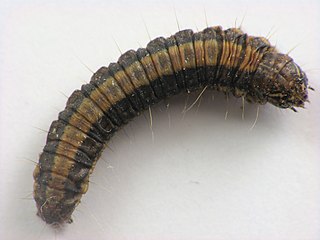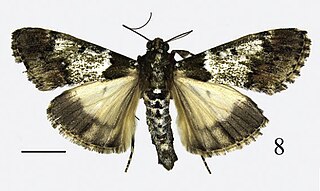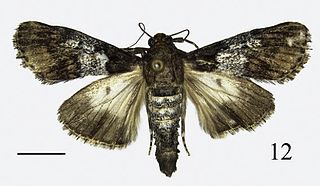
The Pyralidae, commonly called pyralid moths, snout moths or grass moths, are a family of Lepidoptera in the ditrysian superfamily Pyraloidea. In many classifications, the grass moths (Crambidae) are included in the Pyralidae as a subfamily, making the combined group one of the largest families in the Lepidoptera. The latest review by Eugene G. Munroe and Maria Alma Solis retain the Crambidae as a full family of Pyraloidea.

The Pyraloidea are a moth superfamily containing about 16,000 described species worldwide, and probably at least as many more remain to be described. They are generally fairly small moths, and as such, they have been traditionally associated with the paraphyletic Microlepidoptera.

The nutmeg, also known as the clover cutworm, is a moth of the family Noctuidae.

Calamotropha is a genus of moths of the family Crambidae.

Palpita is a genus of moths of the family Crambidae. Members of the moth genus Stemorrhages may be very similar in appearance.

Parapoynx fluctuosalis or Fluctuating China-mark or Waved China-mark, is a moth of the family Crambidae. It is a widespread species, known from Africa, India, Sri Lanka, China, Japan, Malaysia, Taiwan, Guam, Hawaii, Fiji, Australia and the Galápagos Islands. It is also an introduced species in Europe, where it has been recorded from Great Britain, the Iberian Peninsula and Sardinia.

Pyralis manihotalis is a moth of the family Pyralidae described by Achille Guenée in 1854.

Hypsopygia mauritialis is a moth of the family Pyralidae described by Jean Baptiste Boisduval in 1833. It is a widespread species, known from Africa, India, China, Malaysia, Taiwan, Japan, Australia and Hawaii.

Assara is a genus of small moths belonging to the snout moth family (Pyralidae). They are part of the tribe Phycitini within the huge snout moth subfamily Phycitinae.

The Epipaschiinae are a subfamily of snout moths. More than 720 species are known today, which are found mainly in the tropics and subtropics. Some occur in temperate regions, but the subfamily is apparently completely absent from Europe, at least as native species. A few Epipaschiinae are crop pests that may occasionally become economically significant.

Tirathaba is a genus of moths of the family Pyralidae described by Francis Walker in 1864.
Thiallela epicrociella is a species of moth of the family Pyralidae described by Embrik Strand in 1919. It is found in Taiwan.
Epicrocis oegnusalis is a species of moth of the family Pyralidae. It is found in Sierra Leone, Angola, South Africa, Zanzibar, Madagascar, India, Sri Lanka, Nepal, Bangladesh, the Andaman Islands, Burma, Thailand, Singapore, China, Taiwan, Indonesia, the Philippines, New Guinea and Australia.

Teliphasa elegans is a species of moth of the family Pyralidae. It is found in Taiwan, Korea, the Russian Far East, Japan and China.

Teliphasa nubilosa is a species of moth of the family Pyralidae. It is found in China, Taiwan and India.

Teliphasa erythrina is a species of moth of the family Pyralidae. It is found in China (Yunnan).

Teliphasa hamata is a species of moth of the family Pyralidae. It is found in China.

Teliphasa amica is a species of moth of the family Pyralidae. It is found in mainland China, Taiwan, Korea and Japan.
Teliphasa sakishimensis is a species of moth of the family Pyralidae. It is found in China, Taiwan and Japan.
Tirathaba albifusa is a species of moth of the family Pyralidae. It was described by George Hampson in 1917. It is found on Sulawesi.
















